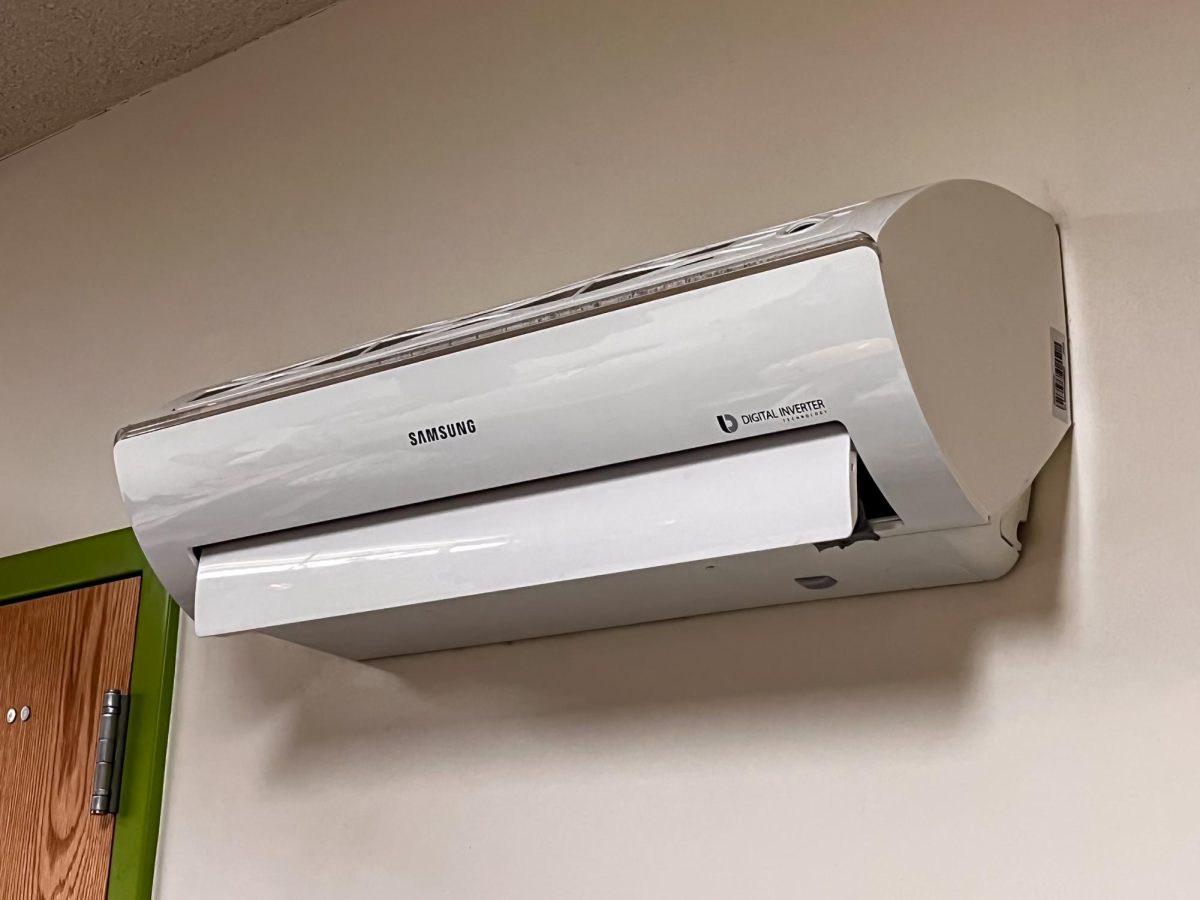
Layla Carlson
A Samsung air conditioning (AC) unit resides on a dorm room wall in Piñon Hall. Student residents in Piñon Hall report a continuous lack of cold air from the ACs in their dorm rooms.
In early August, the air conditioning (AC) on the men’s side of the Piñon Residence Hall stopped producing cold air. Piñon Residents did not realize this would become an ongoing issue, however, heat has become a troublesome topic during the hottest months of the year.
“Week one, when everyone settled in, the AC shit the bed,” freshman nursing major River Parr said. “In the weeks of one through six, it was 80 degrees all the time, and the hot air would just stay in the building because of its limited ventilation.”
Students issued several work orders in an effort to resolve this issue. Maintenance employees attempted to fix the AC, but it broke again shortly after.
“It was unreliable for two weeks straight,” freshman business administration major Sam “Rifle” Funk said. “They fixed it, it broke again literally six hours after, they fixed it the next day, it broke again, they fixed it and it worked for about two weeks until it broke.”
Issues with reliable AC remain ongoing.
“It just recently got fixed last week. It’s so hot in my room and the whole first floor,” Funk said.
According to Piñon residents’ reports, the AC first broke during the week of August 18, right as a heat wave hit western Colorado. The average high temperature of that week was 94 degrees, and some days reached 102.
The heat wave grew in temperature the following week, with the average high sitting at 98 degrees and some of the hottest days hitting 103 degrees. These weather conditions affected the ability for Piñon residents to feel safe staying in their dorms.
“I considered finding a friend who lives in a different hall to [stay] with during the night because it got so hot,” Parr said.
Student residents have tried different strategies for alleviation. Freshman music education major Joey Boris leaves his balcony door open to encourage airflow.
“And I’m sure that’s not very safe, even with us being on the second floor,” he said.
Freshman nursing major Layla Carlson affirmed that she has had people climb up onto her second floor balcony with remarkably little effort.
Boris stated that his AC unit also has been leaking fluid. Regardless of AC functionality, it has made it hard for him and his roommate to trust turning the AC on.
“Me and my roommate just keep it off at all times. It’s right above my desk, too, so I’m just afraid it’s going to drip on my work and assignments,” Boris said. “I can’t even put posters or anything on the wall underneath it, because I’m worried about them getting ruined.”
According to the Residence Life website, Piñon Hall’s yearly rate for the 2025-2026 academic year is $6,350 for a double room and $8,020 for a single room. When presented with the cost of their rooms, knowing one of the basic amenities has not been reliable, Piñon residents felt frustrated.
Parr stated that he believes his room should be discounted as compensation. Boris agreed with this sentiment. Both students also began a petition for Residence Life to fix the air conditioning in the building. They received seven signatures.
“I know [Piñon] is an older building, but if I’m paying over $6,000 per year, that’s coming out of my pocket,” Boris said. “Why am I paying that much just to have my facilities not work?”
One of the Piñon Hall’s Resident Assistants (RA), sophomore energy and land management major Elijah Scherrei, disagreed.
“The facilities workers are doing the best they can to fix it,” he said. “It sucks in the moment, but we kind of have to deal with it. I don’t see any need for compensation.”
Due to his position as an RA, Residence Life is covering Scherrei’s housing costs for the 2025-2026 academic year.
Due to weather conditions beginning to change with the seasons, the inconsistent AC in Piñon Hall is currently not as concerning for students. However, residents express that cool temperatures in their dorms should not be a seasonal benefit dependent on outside temperature fluctuations.